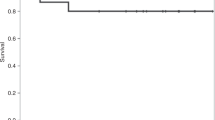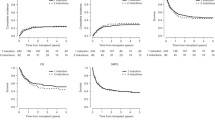Abstract
Umbilical cord blood (UCB) as an allogeneic transplant source is generally limited to units with pre-cryopreservation total nucleated cell (TNC) doses ⩾2.5 × 107 NC/kg. We prospectively investigated single UCB transplantation, with cord units as low as 1 × 107 NC/kg, all processed with post-thaw albumin–dextran dilution. We transplanted 104 adult patients with 84% having relapsed/refractory disease. The median TNC dose was 2.1 × 107 NC/kg (range: 1.0–4.4 × 107) and median CD34+ cell dose was 1.0 × 105/kg (range: 0.0–3.7 × 105/kg). Post-manipulation cell recovery and viability were 96% and 99%, respectively. Median times to neutrophil and platelet engraftment were 16 and 43 days, respectively. Univariate factors predicting neutrophil engraftment included TNC (P=0.03) and CD34+ cell dose (P=0.01). CD34+ dose predicted platelet engraftment (P<0.001). In multivariate analysis, CD34+ dose remained significant for neutrophil and platelet engraftment (P<0.0001 and P<0.0001, respectively). The 100-day and 1-year overall survival were 70% and 46%, respectively (95% confidence interval: 36%–56% at 1 year). The subset transplanted with 1–1.5 × 107 NC/kg had similar 100-day and 1-year survivals of 73% and 45%, respectively. Single-unit UCB transplantation using small units, processed as described, leads to favorable engraftment and acceptable outcomes in poor prognosis patients. CD34+ cell dose (⩾1.5 × 105/kg) helps predict faster engraftment and can aid in graft selection.
This is a preview of subscription content, access via your institution
Access options
Subscribe to this journal
Receive 12 print issues and online access
$259.00 per year
only $21.58 per issue
Buy this article
- Purchase on Springer Link
- Instant access to full article PDF
Prices may be subject to local taxes which are calculated during checkout




Similar content being viewed by others
References
Ballen KK, Gluckman E, Broxmeyer HE . Umbilical cord Blood transplantation: the first 25 years and beyond. Blood 2013; 122: 491–498.
Laroche V, McKenna DH, Moroff G, Schierman T, Kadidlo D, McCullough J . Cell loss and recovery in umbilical cord blood processing: a comparison of postthaw and postwash samples. Transfusion 2005; 45: 1906–1916.
Rubinstein P, Carrier C, Scaradavou A, Kurtzberg J, Adamson J, Migliaccio AR et al. Outcomes among 562 recipients of placental-blood transplants from unrelated donors. N Engl J Med 1998; 339: 1565–1577.
Van Besien K . Advances in umbilical cord blood transplantation - a summary of the 11th International Cord Blood Symposium, San Francisco, 6-8 June 2013. Leuk Lymphoma 2014; 55: 1735–1738.
Barker JN, Byam C, Scaradavou A . How I treat: the selection and acquisition of unrelated cord blood grafts. Blood 2011; 117: 2332–2339.
Barker JN, Scaradavou A, Stevens CE . Combined effect of total nucleated cell dose and HLA match on transplantation outcome in 1061 cord blood recipients with hematologic malignancies. Blood 2010; 115: 1843–1849.
Eapen M, Rocha V, Sanz G, Scaradavou A, Zhang MJ, Arcese W et al. Effect of graft source on unrelated donor haemopoietic stem-cell transplantation in adults with acute leukaemia: a retrospective analysis. Lancet Oncol 2010; 11: 653–660.
Garfall A, Kim H, Cutler C, Ho V, Koreth J, Armand P et al. Allele level matching at HLA-C or –DRB1 is associated with improved survival after reduced intensity cord blood transplantation. Blood 2012; 120: 2010a.
Eapen M, Klein JP, Sanz GF, Spellman S, Ruggeri A, Anasetti C et al. Impact of donor-recipient HLA-matching at HLA A, B, C, and DRB1 on outcome after umbilical-cord blood transplantation for leukaemia and myelodysplastic syndrome: a retrospective analysis. Lancet Oncol 2011; 12: 1214–1221.
Eapen M, Klein JP, Ruggeri A, Spellman S, Lee SJ, Anasetti C et al. Impact of allele-level HLA matching on outcomes after myeloablative single unit umbilical cord blood transplantation for hematologic malignancy. Blood 2014; 123: 133–140.
Laughlin MJ, Barker J, Bambach B, Koc ON, Rizzeri DA, Wagner JE et al. Hematopoietic engraftment and survival in adult recipients of umbilical-cord blood from unrelated donors. N Engl J Med 2001; 344: 1815–1822.
Wagner JE, Barker JN, DeFor TE, Baker KS, Blazar BR, Eide C et al. Transplantation of unrelated donor umbilical cord blood in 102 patients with malignant and non-malignant diseases: influence of CD34 cell dose and HLA disparity on treatment-related mortality and survival. Blood 2002; 100: 1611–1618.
Wagner E, Duval M, Dalle JH, Morin H, Bizier S, Champagne J et al. Assessment of cord blood unit characteristics on the day of transplant: comparison with data issued by cord blood banks. Transfusion 2006; 46: 1190–1198.
Scaradavou A . Unrelated umbilical cord blood unit selection. Semin Hematol 2010; 47: 13–21.
Scaradavou A, Smith KM, Hawke R, Schaible A, Abboud M, Kernan NA et al. Cord blood units with low CD34+ cell viability have a low probability of engraftment after double unit transplantation. Biol Blood Marrow Transplant 2010; 16: 500–508.
Stiff PJ, Murgo AJ, Zaroulis CG, DeRisi MF, Clarkson BD . Unfractionated human marrow cell cryopreservation using dimethylsulfoxide and hydroxyethyl starch. Cryobiology 1983; 20: 17–24.
Kaplan EL, Meier P . Nonparametric estimation from incomplete observations. J Am Stat Assoc 1958; 53: 457–481.
Pasquini MC, Wang Z . Current use and outcome of hematopoietic stem cell transplantation: CIBMTR Summary Slides, 2013. Available at http://www.cibmtr.org.
Przepiorka D, Weisdorf D, Martin P, Klingemann HG, Beatty P, Hows J et al. Consensus conference on acute GVHD grading. Bone Marrow Transplant 1995; 15: 825–828.
Filipovich AH, Weisdorf D, Pavletic S, Socie G, Wingard JR, Lee SJ et al. National Institutes of Health consensus development project on criteria for clinical trials in chronic graft-versus-host disease: I. Diagnosis and staging working group report. Biol Blood Marrow Transplant 2005; 11: 945–955.
Sorror ML, Maris MB, Storb R, Baron F, Sandmaier BM, Maloney DG et al. Hematopoietic cell transplantation (HCT)-specific comorbidity index: a new tool for risk assessment before allogeneic HCT. Blood 2005; 106: 2912–2919.
Rocha V, Gluckman E . Improving outcomes of cord blood transplantation: HLA matching, cell dose and other graft- and transplantation-related factors. B J Haematol 2009; 147: 262–274.
Barker JN, Abboud M, Rice RD, Hawke R, Schaible A, Heller G et al. A ‘no-wash’ albumin-dextran dilution strategy for cord blood unit thaw: high rate of engraftment and a low incidence of serious infusion reactions. Biol Blood Marrow Transplant 2009; 15: 1596–1602.
Dahi PB, Ponce DM, Devlin S, Evans KL, Lubin MN, Gonzales AM et al. ‘No wash’ albumin-dextran dilution for double-unit cord blood transplantation is safe with high rates of sustained donor engraftment. Biol Blood Marrow Transplant 2014; 20: 490–494.
Atsuta Y, Kanda J, Takanashi M, Morishima Y, Taniguchi S, Takahashi S et al. Different effects of HLA disparity on transplant outcomes after single-unit cord blood transplantation between pediatric and adult patients with leukemia. Haematologica 2013; 98: 814–822.
Arcese W, Rocha V, Labopin M, Sanz G, Iori AP, de Lima M et al. Unrelated cord blood transplants in adults with hematologic malignancies. Haematologica 2006; 91: 223–230.
Cohen YC, Scaradavou A, Stevens CE, Rubinstein P, Gluckman E, Rocha V et al. Factors affecting mortality following myeloablative cord blood transplantation in adults: a pooled analysis of three international registries. Bone Marrow Transplant 2011; 46: 70–76.
Ruggeri A, Sanz G, Bittencourt H, Sanz J, Rambaldi A, Volt F et al. Comparison of outcome after single or double cord blood transplantation in adults with acute leukemia using different types of myeloablative conditioning regimen, a retrospective study on behalf of Eucord and the Acute Leukemia Working Party of EBMT. Leukemia 2014; 28: 779–786.
Kindwall-Keller TL, Hegerfeldt Y, Meyerson HJ, Margevicius S, Fu P, van Heeckeren W et al. Prospective study of one- vs two-unit umbilical cord blood transplantation following reduced intensity conditioning in adults with hematological malignancies. Bone Marrow Transplant 2012; 47: 924–933.
Brunstein CG, Gutman JA, Weisdorf Dj, Woolfrey AE, Defor TE, Gooley TA et al. Allogeneic hematopoietic cell transplantation for hematologic malignancy: relative risks and benefits of double umbilical cord blood. Blood 2010; 116: 4693–4699.
Ponce DM, Zheng J, Gonzales AM, Lubin M, Heller G, Castro-Malasapina H et al. Reduced late mortality risk contributes to similar survival after double-unit cord blood transplantation compared with related and unrelated donor hematopoietic stem cell transplantation. Biol Blood Marrow Transplant 2011; 17: 1316–1326.
Rocha V, Rio B, Garnier F, Renaud M, Sirvent A, Takahashi S et al. Reduced intensity conditioning regimen in single unrelated cord blood transplantation in adults with hematological malignant disorders. Blood 2006; 108: 897a.
Ballen KK, Spitzer TR, Yeap BY, McAfee S, Dey BR, Attar E et al. Double unrelated reduced-intensity umbilical cord blood transplantation in adults. Biol Blood Marrow Transplant 2007; 13: 82–89.
Brunstein CG, Barker JN, Weisdorf DJ, DeFor TE, Miller JS, Blazar BR et al. Umbilical cord blood transplantation after nonmyeloablative conditioning: impact on transplantation outcomes in 110 adults with hematologic disease. Blood 2007; 110: 3064–3070.
Brunstein CG, Eapen M, Ahn KW, Appelbaum FR, Ballen KK, Champlin RE et al. Reduced-intensity conditioning transplantation in acute leukemia: the effect of source of unrelated donor stem cells on outcomes. Blood 2012; 119: 5591–5598.
Chen YB, Aldridge J, Kim HT, Ballen KK, Cutler C, Kao G et al. Reduced-intensity conditioning stem cell transplantation: a comparison of double umbilical cord blood and unrelated donor grafts. Biol Blood Marrow Transplant 2012; 18: 805–812.
Wagner JE, Eapen M, Carter S, Wang Y, Schultz KR, Wall DA et al. One-unit versus two-unit umbilical cord blood transplantation for hematologic cancers. N Engl J Med 2014; 371: 1685–1694.
De Lima M, McNiece I, Robinson SN, Munsell M, Eapen M, Horowitz M et al. Cord blood engraftment with ex vivo mesenchymal-cell coculture. N Engl J Med 2012; 367: 2305–2315.
Brunstein CG, McKenna DH, DeFor TE, Sumstad D, Paul P, Weisdorf DJ et al. Complement fragment 3a priming of umbilical cord blood progenitors: safety profile. Biol Blood Marrow Transplant 2013; 19: 1474–1479.
Sureda A, Robinson S, Canals C, Carella AM, Boogaert MA, Caballero D et al. Reduced-intensity conditioning compared with conventional allogeneic stem-cell transplantation in relapsed or refractory Hodgkin’s lymphoma: an analysis from the lymphoma working party of the European Group for blood and marrow transplantation. J Clin Oncol 2008; 26: 455–462.
Sarina B, Castagna L, Farina L, Patriarca F, Benedetti F, Carella AM et al. Allogeneic transplantation improves the overall and progression-free survival of Hodgkin lymphoma patients relapsing after autologous transplantation: a retrospective study based on the time of HLA typing and donor availability. Blood 2010; 115: 3671–3677.
Devetten MP, Hari PN, Carreras J, Logan BR, van Besien K, Bredeson CN et al. Unrelated donor reduced-intensity allogeneic hematopoietic stem cell transplantation for relapsed and refractory Hodgkin lymphoma. Biol Blood Marrow Transplant 2009; 15: 109–117.
Sobol U, Rodriguez T, Smith S, Go A, Vimr R, Parthasarathy M et al. Seven-year follow-up of allogeneic transplant using BCNU, etoposide, cytarabine and melphalan chemotherapy in patients with Hodgkin Lymphoma after autograft failure: importance of minimal residual disease. Leuk Lymphoma 2014; 55: 1281–1287.
Jain S, Stiff PJ, Smith SE, Go A, Parthasarathy M, Rodriguez TE . Myeloablative conditioning with intravenous busulfan and pentostatin (Bu/Pent) Vs total body irradiation and cyclophosphamide (TBI/Cy) for elderly patients with acute myeloid leukemia or myelodysplasia. Blood 2013; 122: 5450–5450.
Acknowledgements
We thank our transplant center’s nursing staff, advance practice nurses, research assistants, social workers and case managers for their invaluable ongoing contributions to patient care.
Author information
Authors and Affiliations
Corresponding author
Ethics declarations
Competing interests
The authors declare no conflict of interest.
Additional information
Supplementary Information accompanies this paper on Bone Marrow Transplantation website
Supplementary information
Rights and permissions
About this article
Cite this article
Sobol, U., Go, A., Kliethermes, S. et al. A prospective investigation of cell dose in single-unit umbilical cord blood transplantation for adults with high-risk hematologic malignancies. Bone Marrow Transplant 50, 1519–1525 (2015). https://doi.org/10.1038/bmt.2015.194
Received:
Revised:
Accepted:
Published:
Issue Date:
DOI: https://doi.org/10.1038/bmt.2015.194
This article is cited by
-
Cord blood index predicts engraftment and early non-relapse mortality in adult patients with single-unit cord blood transplantation
Bone Marrow Transplantation (2021)
-
Unit selection for umbilical cord blood transplantation for adults with acute myeloid leukemia in complete remission: a Japanese experience
Bone Marrow Transplantation (2019)



